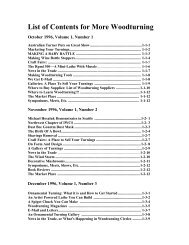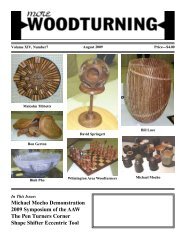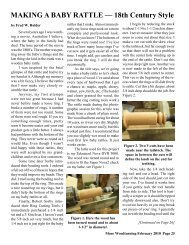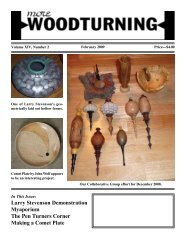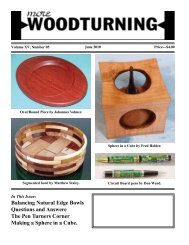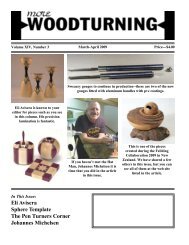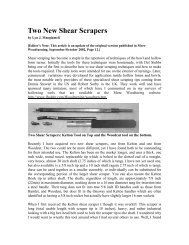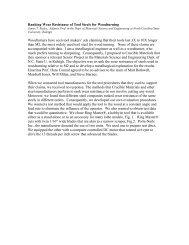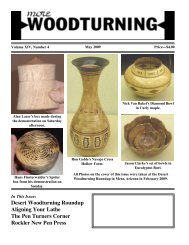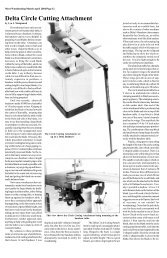CUTTING SCREWS IN WOOD BY THE HAND CHASERby James Lukin[Reprinted from Turning <strong>Lathe</strong>s, Aguide to Turning, Screw-Cutting,Metal-Spinning, Ornamental Turning,Etc., Fourth Edition, 1894. Thisbook has been reprinted and is currentlyavailable from The AstragalPress, Mendham, New Jersey.]This somewhat difficult artis well worth all the trouble that itneeds to acquire it. As soon as it isgained, it renders the work moreindependent of all costly apparatusused to render the process easy tosuch as cannot succeed with handtools alone, and the screw can bemade in a shorter time than it takesto set up even the simplest of suchapparatus; but it would be a mistaketo suppose the art in question easy ofacquirement, and it needs constantpractice to keep up the knack of usingthe chaser.The directions given by mostof our leading authorities are asfollows: “Having turned smoothand true the cylinder upon whichthe screw is to be traced, round offthe edge or arris so that it shall notcatch into the teeth at starting, andcheck the traverse of the tool. Therest is placed very near the work,and must have its edge filed smoothand level if it is at all notched fromother work.The tool is to be held by itshandle in the right hand, and itsblade between the first finger andthumb, so as to cushion it somewhat,and allow it barely to lie on the rest.Then the <strong>Lathe</strong> is to be set in easymotion, and after a trial or two,without actually touching the work,just to get the swing of it, a steady,Figure 1. Shows the Methods of striking threads recommended byHoltzapffel in his book, Hand or Simple Turning. Holtzapffel directsthat the first stroke of the chaser be across the center of the curvewhere the sharp angle has been turned off. The arc a-b is the firststroke and arc c-d is the second.decisive cut is to be attempted, traversingthe tool without nervousnessor hesitation.”Exactly so; but, unless theworkman is already an adept, thechances are sadly against his hittingoff the thread; and, knowing this, hewill be as nervous as a skater makinghis first essay on the ice.Yet there is no royal road toscrew-cutting, and the above directionsare as good as any. The bestway is to cut threads outside chucks,and any odd bits of boxwood, on alloccasions: go at it and keep at it, andthe skill will not long be wanting.The inside thread has also tobe struck haphazard, only the movementof the tool is now straightforward into the hole. Many use forthis purpose an arm rest, which is along-handled, flat bar of iron, about1/2-inch. wide, tapering down toabout 1/4-inch. at the extremity. Theend is turned up 1/4-inch., and thechaser rests on the end just behindthis hook.The “T” of the rest is now retainedin its usual position parallelto the <strong>Lathe</strong> bed, and the arm restis held under the left armpit, withthe blade of it across the rest. Thisplaces the shank and hook at rightangles, or nearly so, across the faceof the hollowed work, and the toolis laid on it, instead of having toturn round the “T” of the rest itself.The hands grasp the end of the armrest as well as the tool, so that thetwo move as one. A great deal ofinside work, besides screw-cutting,is done with this contrivance, as itprevents having to shift round the“T” of the rest.Inside screws are easier to cutwith its aid, as it moves on the “T”Page 36 <strong>More</strong> <strong>Woodturning</strong> February 2010
as on a fulcrum, and gives to the toolan easy swing, as if it moved on aball-and-socket joint.Each cut of the chaser, especiallyat the commencement, mustbe very light, and it must carry itselfalong by the thread first traced, andnot be driven in the least until thethread is well and deeply cut.The great difficulty will befound with the coarse pitches: thefiner, from 16 to 24, are easier thanfrom 8 to 16 the traverse of the latteris necessarily so much faster andmore difficult to hit off, as regardsspeed. Except for chucks and largeboxwood cases, it is not often thatthe course pitches will be needed,and 12 to 24 will amply suffice forgeneral purposes.Holtzapffel, in his valuablework, directs that the first stroke ofthe chaser is to be across the centerof the curve where the sharp anglehas been turned off, like Figure 1,a-b showing the first stroke, and c-dthe second. Thus, the screw is graduallyworked round to the cylindricalpart. The traverse is, of course,from right to left, and from theedge to the interior of hollow work.Personally, I have found it quite aseasy to begin at once upon the endof the cylindrical part; but it is, Isuppose, a question of habit. I havealso generally found it better at thecommencement to keep the pointsclear, and to let the tool touch justbelow them. This will carry it alongsufficiently to let the required speedof traverse be seen, after which thetool may be lowered, so as to bringinto action its full cutting powers.But there is no sort of doubt aboutthe difficulty of screw-chasing byhand a difficulty that is only to be[Contued on Page 39]<strong>Woodturning</strong> Books For SaleWe are pleased to offer the following books from Linden Publishing forsale through <strong>More</strong> <strong>Woodturning</strong>.Here are the titles we are offering:• All Screwed up!: Turned Puzzles and Boxes Featuring Chased threadsby John Berkeley $24.95• 500 Wood Bowls $24.95• Beyond Basic Turning: Off-Center, Coopered, and Laminated Work,by Jack Cox $28.95• Chris Child’s Projects for Woodturners, by Chris Child $16.95• Decorating Turned Wood: The Maker’s Eye, by Liz and MichaelO’Donnell $19.95• Fabulous Turned Wood Projects, by Hazeu Hiebert, et al $17.95• Richard Raffan Turning Guides, Slipcase Set, by Richard Raffan $59.95• Segmented Turning: A Complete Guide, by Ron Hampton $19.95• The Art of Segmented Wood Turning: A Step-by-Step Guide,by Malcolm Tibbetts $25.95• The Complete Illustrated Guide to Turning by Richard Raffan $39.95• The <strong>Lathe</strong> Book, by Ernie Conover $24.95• The Woodturner’s Workbook, by Ray Key $19.95• The Woodturner’s FAQ Book, by Fred Holder $19.95• Turn a Bowl: Getting Good Results the First Time Around,by Ernie Conover $19.95• Turned Boxes: 50 Designs, by Chris Stott $19.95• Turning Boxes with Richard Raffan: (revised and updated) $24.95• Turning Bowls with Richard Raffan, by Richard Raffan $24.95• Turning Boxes with Richard Raffan $24.95• Turning Green Wood, by Michael O’Donnell $17.95• Turning Pens and Pencils, by Kip Christensen & Rex Burningham $17.95• Turning Projects, by Richard Raffan $21.95• Turning Wood with Richard Raffan, by Richard Raffan $24.95• Wood for Woodturners by Mark Baker $19.95• <strong>Woodturning</strong>: A Foundation Course, by Keith Rowley $19.95• <strong>Woodturning</strong>: A Fresh Approach, by Robert Chapman $17.95• <strong>Woodturning</strong> Forms and Materials, by John Hunnex $19.95• <strong>Woodturning</strong> Projects, by Mark Baker $19.95• Woodturner’s Wooden Clock Cases by Tim Ashby $5.95Pay shipping of $4.25 for the first book plus $1.00 for each additional book.Priority Mail is $6.50 for the first book and $1.00 for each additonal book.Foreign Customers please request a quote for shipping costs.Order three books and take a 10 percent discount on the order.Note: Discount does not apply to postage.Master Card and Visa Charge Cards AcceptedSend Orders to:<strong>More</strong> <strong>Woodturning</strong>P. O. Box 2168Snohomish, WA 98291-2168Telephone: 360-668-0976Fax: 360-668-1798Page 37 <strong>More</strong> <strong>Woodturning</strong> February 2010



